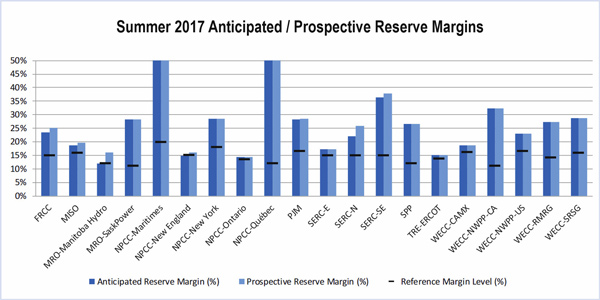By Michael Brooks
Planning reserve margins across most of the U.S. are expected to be adequate for a hotter-than-normal summer, with only ISO-NE barely missing its NERC target, FERC said in its annual summer reliability report released Thursday.
The report analyzed reference levels and margins for all U.S. RTOs and ISOs, as well as NERC’s SERC Reliability, Florida Reliability Coordinating Council and Western Electricity Coordinating Council regions.
ISO-NE is expected to come in just shy of its 15.1% target with a 14.88% reserve margin. FERC staff said tight supply conditions could develop as a result of about 700 MW of new resources not coming online as expected.
“ISO-NE may be required to rely on additional imports from neighboring regions as well as implementing operating procedures to maintain reliability during possible periods of supply deficiencies,” the report said.
While ERCOT’s reserve margin is also tight, the ISO expects to have sufficient capacity to meet peak summer demand, with only a few local areas in southern and western Texas at risk of reliability issues, partially because of strong load growth.
SPP is expected to exceed its target the most; the RTO recently reduced its reserve margin to 12% from 13.6%. (See Waiting on FERC, SPP Members Cut Reserve Margin.)
NERC data show total U.S. generating capacity has risen by about 1% since last summer, matching a comparable increase in load. This comes despite the retirement of about 10 GW of combined coal- and natural gas-fired capacity over the last year.
This summer will see an additional 20 GW of new capacity, mostly from wind and solar resources, FERC staff said. NERC anticipates that total wind capacity will be up 8% over last year to 82 GW. The only new nonrenewable resources: 2 GW of gas-fired capacity in the Eastern Interconnection.
“The growing importance of renewable resources has continued in recent years, as both wind and solar capacity continue to expand,” FERC staff said. “Grid operators are pursuing operational solutions to better integrate wind and solar resources as part of their operational and planning activities.”
Staff noted the near record-high levels of snowpack in the West, particularly California, which could boost reliance on hydropower to mitigate any possible natural gas constraints stemming from the restrictions on the Aliso Canyon storage facility.
“While the restrictions on Aliso Canyon did not pose any major issues during the 2016 summer, the limited availability of the Aliso Canyon natural gas storage facility in Southern California may pose a risk to gas and electric reliability this summer if hotter-than-normal weather conditions and unplanned gas pipeline outages materialize,” the report said.
The National Oceanic and Atmospheric Administration is forecasting above-normal summer temperatures for most of the continental U.S., with the entire East Coast most likely to see an increase over the average.




